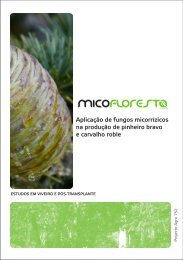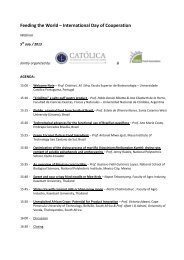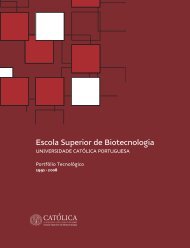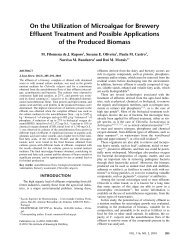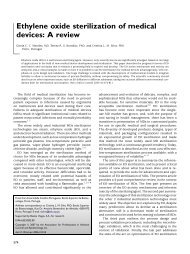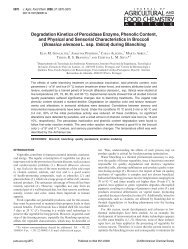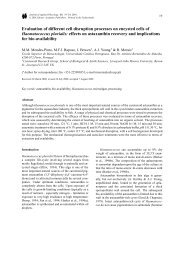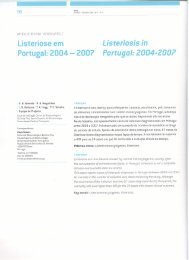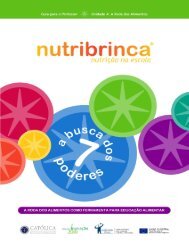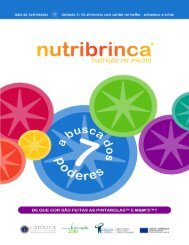View - Escola Superior de Biotecnologia - Universidade Católica ...
View - Escola Superior de Biotecnologia - Universidade Católica ...
View - Escola Superior de Biotecnologia - Universidade Católica ...
You also want an ePaper? Increase the reach of your titles
YUMPU automatically turns print PDFs into web optimized ePapers that Google loves.
Eur J Clin Microbiol Infect Dis<br />
DOI 10.1007/s10096-010-0988-x<br />
ARTICLE<br />
Distribution and characterization of Listeria monocytogenes<br />
clinical isolates in Portugal, 1994–2007<br />
G. Almeida & A. Morvan & R. Magalhães & I. Santos &<br />
T. Hogg & A. Leclercq & P. Teixeira & Research Team<br />
Received: 19 January 2010 /Accepted: 29 May 2010<br />
# Springer-Verlag 2010<br />
Abstract In recent years, the number of cases of listeriosis<br />
has increased worldwi<strong>de</strong>. Ninety-five isolates of Listeria<br />
monocytogenes recovered from Portuguese human cases of<br />
listeriosis have been characterized by biotyping (cadmium<br />
and arsenic sensitivity), polymerase chain reaction (PCR)<br />
grouping, and by pulsed-field gel electrophoresis (PFGE)<br />
applying the enzymes AscI and ApaI. Isolates were<br />
classified into one of three PCR groups; IVb (71.6%), IIb<br />
(17.9%), and IIa (10.5%). Four biotypes were differentiated:<br />
sensitive to arsenic/cadmium (48.4%), arsenic-sensitive<br />
and cadmium-resistant (25.3%), resistant to arsenic and<br />
sensitive to cadmium (18.9%), and resistant to both<br />
heavy metals (7.4%). Combined analyses of AscI and<br />
ApaI patterns yiel<strong>de</strong>d a total of 58 PFGE types with five<br />
sets (G, Jb, KKa, Me, and U) of Portuguese strains, each<br />
of which were indistinguishable by PFGE typing. In the<br />
present study, it was <strong>de</strong>monstrated that there are recurrent<br />
pulsotypes and that some were the same pulsotypes linked<br />
to outbreaks in France. In addition, there are some<br />
pulsotypes spread throughout the country, while others<br />
only appear in a restricted region. This study allowed the<br />
assembly of a first large pulsotype database of Portuguese<br />
clinical strains.<br />
G. Almeida : R. Magalhães : I. Santos : T. Hogg : P. Teixeira (*)<br />
Centro <strong>de</strong> <strong>Biotecnologia</strong> e Química Fina, <strong>Escola</strong> <strong>Superior</strong><br />
<strong>de</strong> <strong>Biotecnologia</strong>, Universida<strong>de</strong> <strong>Católica</strong> Portuguesa,<br />
Rua Dr António Bernardino <strong>de</strong> Almeida,<br />
4200-072 Porto, Portugal<br />
e-mail: pcteixeira@esb.ucp.pt<br />
A. Morvan : A. Leclercq<br />
Laboratoire <strong>de</strong>s Listeria, Centre National <strong>de</strong> Référence <strong>de</strong>s<br />
Listeria et Centre Collaborateur <strong>de</strong> l’Organisation Mondiale <strong>de</strong> la<br />
Santé pour la Listériose d’Origine Alimentaire, Institut Pasteur,<br />
25, Rue du Docteur-Roux,<br />
75724 Paris ce<strong>de</strong>x 15, France<br />
Introduction<br />
Listeria monocytogenes is recognized as a major, opportunistic,<br />
foodborne pathogen in humans. The condition which<br />
this species causes, listeriosis, occurs worldwi<strong>de</strong> both<br />
sporadically and epi<strong>de</strong>mically, and has a case–fatality rate<br />
between 20 and 30%. L. monocytogenes has the ability to<br />
cross the intestinal, blood–brain, and fetoplacental barriers,<br />
and, thus, septicemia, central nervous system (CNS)<br />
infections, miscarriages, and stillbirths are risks to immuno<strong>de</strong>ficient<br />
or pregnant individuals [1].<br />
In Portugal, listeriosis is not a notifiable disease and has,<br />
thus, been un<strong>de</strong>restimated. Nevertheless, Almeida et al. in<br />
2006 [2], in a retrospective study, reported an estimated<br />
inci<strong>de</strong>nce of at least 1.4 cases per million inhabitants in<br />
2003. The implementation of an active surveillance<br />
program in the Netherlands led to a 43% increase in the<br />
reported inci<strong>de</strong>nce of listeriosis in the first year of operation<br />
[3]. This might give some indication of the current <strong>de</strong>gree<br />
of un<strong>de</strong>restimation in Portugal. Any such program would<br />
certainly omit reporting some sporadic cases and spontaneous<br />
miscarriages, as these are often not investigated. Since<br />
2005, several European countries reported an increase of<br />
listeriosis and several foodborne outbreaks have been<br />
reported [4]. Some examples are the outbreaks which<br />
occurred in Switzerland associated with Tome cheese [5],<br />
in the United Kingdom associated with sandwich consumption<br />
[6], in the Czech Republic associated with soft cheese<br />
[7], and a recent multinational outbreak due to the<br />
consumption of “Quargel” cheese in Austria and Germany<br />
[8].<br />
The characterization of L. monocytogenes strains can be<br />
based on its molecular subtyping by polymerase chain<br />
reaction (PCR) grouping or geno-serotyping [9] and by<br />
macrorestriction pulsotype analysis of its DNA using the
PulseNet protocol [10]. The use of subtyping methods to<br />
differentiate strains (or subtypes) of L. monocytogenes has<br />
important epi<strong>de</strong>miological applications: rapid, precise, and<br />
efficient foodborne listeriosis surveillance can minimize<br />
outbreaks and track sources of L. monocytogenes contamination<br />
throughout the food system. Moreover, molecular<br />
subtyping in listeriosis surveillance would allow the<br />
<strong>de</strong>tection of clusters of cases that could be erroneously<br />
consi<strong>de</strong>red as sporadic cases.<br />
The association between a particular pulsotype and<br />
specific virulence traits is another possibility offered by<br />
molecular subtyping [11].<br />
The study presented here was initiated in 2003, with a<br />
view to support the establishment of an integrated, food<br />
chain surveillance system in Portugal. Ninety-five clinical<br />
Portuguese isolates recovered from apparently sporadic<br />
cases of listeriosis were collected, i<strong>de</strong>ntified, biotyped by<br />
cadmium and arsenic sensitivity, geno-serotyped, and<br />
typed by DNA macrorestriction pulsed-field gel<br />
electrophoresis (PFGE). The aim was to obtain<br />
epi<strong>de</strong>miological data on cases of listeriosis in the country<br />
and to construct a molecular type database of clinical<br />
strains of L. monocytogenes.<br />
Materials and methods<br />
Collection of L. monocytogenes strains and related data<br />
to listeriosis episo<strong>de</strong>s<br />
A total of 95 L. monocytogenes strains isolated between<br />
1994 and 2007 were collected from major Portuguese<br />
hospitals. The case <strong>de</strong>finition of listeriosis employed was<br />
that contained in Commission Decision 2002/253/CE [12].<br />
Thus, on isolation of L. monocytogenes from a hospitalized<br />
patient with a clinical compatible illness, each strain was<br />
consi<strong>de</strong>red as a single case of listeriosis. A case was<br />
<strong>de</strong>fined as maternal/neonatal (MN) in the following<br />
situations: infected pregnant woman, miscarriage, stillbirth,<br />
or newborn less than one month of age. Only one strain was<br />
kept when the pathogen was isolated from both the<br />
pregnant woman and her newborn child. If a case did not<br />
apply to any of these, it was consi<strong>de</strong>red as non-maternal/<br />
neonatal (non-MN). Information regarding gen<strong>de</strong>r and age<br />
of the patient, the tissue or fluid origin where the bacteria<br />
was isolated, and the year of isolation was reported when<br />
available.<br />
Confirmed isolates of L. monocytogenes were stored in<br />
Tryptic Soy Broth with 30% (v/v) glycerol at −80° C<br />
in the culture collection of the <strong>Escola</strong> <strong>Superior</strong> <strong>de</strong><br />
<strong>Biotecnologia</strong>.<br />
Biotyping by arsenic and cadmium sensitivity<br />
The characterization of their differential resistance to<br />
arsenic and cadmium was performed in Isosensitest agar<br />
plates (ISA, Oxoid, Hampshire, UK) containing 500 µg/ml<br />
sodium arsenite (Merck, Darmstadt, Germany) or 75 µg/ml<br />
cadmium chlori<strong>de</strong> (Merck) [13, 14].<br />
Geno-serotyping or PCR grouping<br />
Geno-serotyping was <strong>de</strong>termined by PCR grouping with a<br />
multiplex PCR as <strong>de</strong>scribed by Doumith et al. [9] using primers<br />
targeting fragments of genes lmo0737, ORF2819, ORF<br />
2110, lmo1118, and prs (MWG-Biotech, Muenchenstein,<br />
Switzerland). PCR was performed in an Eppendorf<br />
thermocycler (Eppendorf, Hamburg, Germany) and PCR<br />
products were resolved on a 2% agarose gel containing<br />
0.5 µg/ml of ethidium bromi<strong>de</strong> (Eurobio, Courtaboeuf,<br />
France) and visualized and photographed un<strong>de</strong>r a UV<br />
transilluminator (Bio-Rad Gel Doc 2000 imaging<br />
system, Bio-Rad Laboratories, Milan, Italy).<br />
Molecular characterization by PFGE<br />
Eur J Clin Microbiol Infect Dis<br />
The DNA macrorestriction was performed at the Centre<br />
National <strong>de</strong> Référence <strong>de</strong>s Listeria, Institut Pasteur (Paris,<br />
France) with the restriction enzymes AscI (New England<br />
BioLabs, Massachusetts, Ipswich, USA) and ApaI (MBI<br />
Fermentas, Burlington, Canada), as previously <strong>de</strong>scribed by<br />
Graves and Swaminathan [10].<br />
The pulsotypes obtained were scanned and the computerized<br />
data were analyzed using BioNumerics software<br />
version 5.1 (Applied Maths, Kortrijk, Belgium). Bands<br />
automatically assigned by the computer were checked<br />
visually and corrected manually when necessary. A position<br />
tolerance of 1.5 was selected for each PFGE. Cluster<br />
analysis of the individual or combined PFGE pulsotypes<br />
was done by the unweighted pair group method with<br />
average linkages (UPGMA), using the Dice coefficient to<br />
analyze the similarities of the banding pulsotypes. The<br />
discriminatory power was <strong>de</strong>termined by calculating the<br />
discrimination in<strong>de</strong>x (D) based on Simpson’s in<strong>de</strong>x of<br />
diversity, as <strong>de</strong>scribed by Hunter and Gaston [15].<br />
Two PFGE patterns were consi<strong>de</strong>red to be indistinguishable<br />
when their similarity was higher than 98% [16] and a<br />
capital letter was ascribed to AscI pulsotype; when strains<br />
were similar at more than 98% by AscI but not similar at<br />
more than 98% by ApaI, they were <strong>de</strong>noted, in addition to<br />
the capital letters, by lowercase letters.<br />
PFGE pulsotypes of indistinguishable Portuguese strains<br />
were compared with PFGE pulsotypes of the French PFGE<br />
database of the Centre National <strong>de</strong> Référence <strong>de</strong>s Listeria
Eur J Clin Microbiol Infect Dis<br />
using the BioNumerics software package as previously<br />
<strong>de</strong>scribed in this section.<br />
Statistical analysis<br />
The statistical package used for the analyses was Stata<br />
v10.0 (StataCorp LP, College Station, TX, USA). The<br />
contingency table analysis was based on the Chi-square<br />
distribution (Pearson’s Chi-square test).<br />
Results<br />
Data collected from human episo<strong>de</strong>s<br />
A total of 95 isolates from cases of listeriosis were<br />
collected from major Portuguese hospitals during the<br />
study period. From the information available on 81 cases<br />
(Table 1), 85.2 and 14.8% correspon<strong>de</strong>d to non-MN<br />
infections and MN infections, respectively. For the 69<br />
confirmed non-MN cases, strains were isolated from blood<br />
(58.0%), from cerebrospinal fluid (34.8%), and from other<br />
specimens (7.2%). The clinical symptoms were not<br />
recor<strong>de</strong>d for the majority of cases. The gen<strong>de</strong>r ratio (M/<br />
F) of confirmed non-MN cases was 2.3. The mean age of<br />
non-MN cases with documented age was 60 years, with 38<br />
cases (55.9%) being equal or up to 60 years. The<br />
geographical distribution of listeriosis cases was difficult<br />
to <strong>de</strong>fine from our collected data in the absence of data on<br />
the resi<strong>de</strong>nce of patients.<br />
Biotyping results by arsenic and cadmium sensitivity<br />
Four groupings of sensitivity to heavy metals were<br />
differentiated among the 95 isolates (Table 1), the D-value<br />
for this biotyping method being 0.667. The predominant<br />
group—sensitive to both arsenic (As) and cadmium (Cd)—<br />
contains 46 isolates (48.4%). Twenty-four isolates were<br />
arsenic-sensitive and cadmium-resistant (25.3%), 18 were<br />
resistant to arsenic and sensitive to cadmium (18.9%), and<br />
seven were resistant to both heavy metals (7.4%).<br />
PCR grouping results<br />
Three PCR groups were i<strong>de</strong>ntified in the 95 L. monocytogenes<br />
isolates recovered from sporadic human listeriosis cases in<br />
Portugal. Most isolates were of PCR group IVb (including<br />
serotypes 4b or 4d or 4e) 71.6% (n=68): 17.9% (n=17) and<br />
10.5% (n=10) of the isolates showed PCR group IIb<br />
(including serotypes 1/2b or 3b) and PCR group IIa<br />
(including serotypes 1/2a or 3a), respectively. The D-value<br />
obtained from these PCR grouping results was 0.449.<br />
Combining the results from PCR grouping and sensitivity<br />
to heavy metals, it was possible to segregate the 95 isolates<br />
into nine groups (D=0.831). Two groups predominate: PCR<br />
group IVb, As- and Cd-sensitive (30.5%); PCR group IIb,<br />
As-resistant and Cd-sensitive (17.9%).<br />
PFGE results<br />
PFGE typing revealed a total of 39 AscI and 50 ApaI<br />
macrorestriction types among clinical isolates, distinguished<br />
by one or more band differences ranging in<br />
molecular size from 50 to 500 kb (Fig. 1). Combined<br />
analyses of AscI and ApaI PFGE data yiel<strong>de</strong>d a total of<br />
58 PFGE pulsotypes, with D=0.966 for AscI, D=0.979 for<br />
ApaI, and D=0.986 for combined AscI and ApaI.<br />
Comparisons based on such combined patterns are<br />
reported in Table 1 and the corresponding <strong>de</strong>ndrogram in<br />
Fig. 1.<br />
Pulsotypes DD, EE, FF, G, HHb, Jb, KKa, La, LLa,<br />
LLb, Me, MM, Pb, S, T, U, V, and Ya contained two or<br />
more strains which remained indistinguishable from each<br />
other. Only the pulsotypes FF, LLb, MM, Pb, T, U, V, and<br />
Ya contained indistinguishable strains by Cd and As<br />
sensitivity.<br />
Pulsotypes DD, EE, FF, HHb, Jb, KKa, La, LLa, LLb,<br />
Me, MM, Pb, S, and T were constituted of L. monocytogenes<br />
isolates from geno-serotype IVb, pulsotypes U, V, and<br />
Ya of geno-serotype IIb, and pulsotype G of geno-serotype<br />
IIa.<br />
While strains of pulsotypes DD, FF, HHb, La, LLa, LLb,<br />
MM, Pb, S, T, V, and Ya were recovered from different<br />
years and geographical distribution, pulsotypes EE, G, Jb,<br />
KKa, Me, and U were related in time or geographical<br />
distribution. Two pulsotypes (U and KKa) have six<br />
indistinguishable strains. Three pulsotype U strains were<br />
isolated in the Lisbon region, respectively in February<br />
2004, August 2004, and October 2004, with the same Cd<br />
and As sensitivity. Two pulsotype KKa strains having the<br />
same Cd and As sensitivity were isolated in March and in<br />
April 2004.<br />
Pulsotype G contained two indistinguishable strains but<br />
with distinct Cd and As sensitivity isolated in February and<br />
May 2006 in different towns.<br />
Concerning pulsotype EE, two indistinguishable strains<br />
but with distinct Cd and As sensitivity were isolated in<br />
different hospitals in Porto in 2007 six months apart, from a<br />
woman and a newborn child.<br />
The pulsotype Jb contained three indistinguishable<br />
strains isolated in Lisbon in March 2006, September<br />
2006, and June 2007. Pulsotype Me is constituted by four<br />
indistinguishable strains, three of which were isolated in the<br />
Porto region over a period of one year.
Table 1 Listeria monocytogenes strains used in this study and collected epi<strong>de</strong>miological data concerning the cases with which they were<br />
associated<br />
Isolate Hospital localization Year of isolation Clinical form a<br />
Patient<br />
gen<strong>de</strong>r/age b<br />
PCR group<br />
(geno-serotype)<br />
Eur J Clin Microbiol Infect Dis<br />
Susceptibility<br />
to As/Cd c<br />
PFGE combined type<br />
U I<br />
771 Porto 2003 M Un / < 1 month IVb S/S S<br />
779 Porto 2000 NM F / 25 IVb S/R HHa<br />
780 Porto 1996 NM M / Un IVb S/S HHb<br />
781 Porto 2000 M Un / < 1 month IVb S/R HHb<br />
783 Porto 1994 M Un / < 1 month IVb R/S S<br />
784 Porto 1999 M Un / < 1 month IVb R/R Ma<br />
856 Chaves 2003 NM M / 50 IVb R/S Ka<br />
866 Matosinhos 2003 NM M / 67 IVb S/S R<br />
908 Chaves 2003 NM M / 48 IVb R/R HHb<br />
999 Coimbra 2000 NM M / 48 IIb S/S Z<br />
1001 Porto 2004 NM M / 65 IVb R/R KKa<br />
1002 Almada 1998 NM M / 54 IIb S/S NN<br />
1003 Almada 2003 NM F / 85 IVb S/S LLa<br />
1037 Chaves 2004 NM F / 74 IVb S/S Pd<br />
1059 Matosinhos 2004 NM F / 73 IVb S/R HHb<br />
1062 Lisbon 2004 NM M / 54 IIb S/S W<br />
1063 Lisbon 2002 NM M / Un IVb S/S FF<br />
1065 Lisbon 2004 NM M / Un IIb S/S U<br />
1198 Matosinhos 2004 NM M / 74 IIa S/S H<br />
1239 Matosinhos 2004 M Un / < 1 month IVb R/S BB<br />
1240 Almada 2004 M F / < 1 month IIb S/S U<br />
1241 Coimbra 2004 NM M / 44 IVb R/R KKa<br />
1242 Lisbon 2004 NM M / 57 IIb S/S U<br />
1244 Lisbon 2004 NM M / 46 IVb R/S N<br />
1348 Almada 2005 NM F / 77 IIb S/S U<br />
1383A Lisbon 2005 NM M / 40 IVb R/R JJ<br />
1541 Coimbra 2000 NM Un / Un IVb S/S LLb<br />
1542 Coimbra 2000 NM Un / Un IVb S/R HHc<br />
1543 Coimbra 2000 NM Un / Un IVb S/S Ja<br />
1544 Coimbra 2000 NM Un / Un IVb S/S DD<br />
1545 Coimbra 2003 M F / 31 IIb S/S Ya<br />
1546 Coimbra 2001 NM M / 41 IVb S/S Pc<br />
1547 Coimbra 2001 NM M / 85 IIb S/S U<br />
1548 Coimbra 1999 NM Un / Un IVb S/S KKa<br />
1549 Coimbra 1999 NM Un / Un IVb S/R MM<br />
1550 Coimbra 1997 NM Un / Un IVb S/S LLc<br />
1551 Coimbra 1997 NM Un / Un IVb S/S T<br />
1552 Coimbra 1997 NM Un / Un IVb S/S Md<br />
1553 Coimbra 1998 NM Un / Un IVb R/S La<br />
1554 Coimbra 1999 NM Un / Un IVb S/R KKa<br />
1555 Coimbra 2003 NM F / 74 IVb S/S T<br />
1556 Coimbra 2005 NM F / 56 IVb S/S Pb<br />
1562/1 Lisbon 2005 NM M / 81 IIb S/R Yb<br />
1621/1 Lisbon 2005 NM F / 72 IVb S/S LLb<br />
1761 Coimbra 2005 NM M / 57 IIb S/R A<br />
1762 Coimbra 2005 M F / 33 IIb S/R V<br />
1763 Coimbra 2005 NM M / 51 IVb R/S Mf<br />
1764 Coimbra 2005 M Un / < 1 month IVb S/R KKc<br />
1765 Coimbra 2005 M F / 31 IVb S/S Kb<br />
1766 Braga 2005 NM F / 4 months IVb S/R Me<br />
1767 Braga 2005 NM F / 46 IVb S/R KKa<br />
1768 Matosinhos 2006 M F / 31 IVb R/S Me<br />
1792 Lisbon 2006 NM M / 34 IVb R/S Jb<br />
1796 Lisbon 2006 NM F / 80 IIb S/R V
Eur J Clin Microbiol Infect Dis<br />
Table 1 (continued)<br />
Isolate Hospital localization Year of isolation Clinical form a<br />
Patient<br />
gen<strong>de</strong>r/age b<br />
PCR group<br />
(geno-serotype)<br />
Susceptibility<br />
to As/Cd c<br />
PFGE combined type<br />
U I<br />
1803 Matosinhos 2006 NM M / 77 IVb R/S Lb<br />
1807/1 Lisboan 2006 NM F / 68 IVb S/R KKa<br />
1878 Lisbon 2006 NM M / 70 IVb S/S LLa<br />
1879 Lisbon 2006 NM M / 58 IVb R/R Jb<br />
1880 Porto 2006 NM M / 78 IIa S/S C<br />
1891 Braga 2006 NM M / 60 IIa S/S F<br />
1999 Lisbon 2006 NM M / 70 IVb S/S KKb<br />
2029 Lisbon 2007 NM F / 81 IIa S/R D<br />
2064 Matosinhos 2006 NM M / 63 IVb R/S La<br />
2065 Matosinhos 2007 NM F / 79 IIb S/R X<br />
2074 Porto 2007 M Un / < 1 month IVb S/S EE<br />
2076 Lisbon 2007 NM F / 50 IIb S/S Ya<br />
2085 Lisbon 2007 NM F / 73 IVb S/S Pa<br />
2086 Matosinhos 2007 NM M / 84 IIa S/S B<br />
2087 Lisbon 2007 NM M / 50 IVb S/R Mc<br />
2088 Porto 2006 NM M / 77 IVb S/S FF<br />
2090 Porto 2006 NM M / 54 IVb S/R Me<br />
2091 Porto 2006 NM M / 61 IIa R/S G<br />
2092 Braga 2007 NM M / 78 IVb R/S Mb<br />
2093 Braga 2007 NM M / 77 IVb R/R GG<br />
2094 Funchal 2007 NM F / 53 IVb S/S FF<br />
2095 Almada 2007 NM F / 88 IIb S/S Q<br />
2096 Porto 2005 NM M / 40 IVb S/S La<br />
2097 Coimbra 2006 NM F / 81 IVb R/S DD<br />
2098 Coimbra 2006 NM M / 83 IIb S/R AA<br />
2099 Coimbra 2006 NM M / 53 IIa S/S G<br />
2100 Coimbra 2006 NM F / 70 IVb S/S FF<br />
2101 Coimbra 2007 NM M / 66 IVb S/S II<br />
2102 Lisbon 2007 NM M / 74 IVb R/S Jb<br />
2103 Lisbon 2007 NM M / 19 IIa S/S E<br />
2104 Coimbra 2006 NM F / 68 IVb S/R MM<br />
2105 Coimbra 2007 NM M / 43 IVb S/R MM<br />
2117 Braga 2007 NM M / 76 IVa S/S CC<br />
2121 Braga 2007 NM M / 34 IIb S/S U<br />
2122 Lisbon 2007 NM M / 88 IVb S/S Pb<br />
2125 Funchal 2007 NM M / 58 IVb R/S EE<br />
2135 Lisbon 2007 NM M / 52 IIa S/R I<br />
2252 Porto 2007 NM M / 50 IVb R/S Me<br />
2253 Porto 2007 NM M / 60 IVb R/S DD<br />
2254 Porto 2007 NM M / 69 IVb S/S O<br />
2255 Porto 2007 NM F / 26 IVa R/S EE<br />
Strains not similar at more than 98% by PFGE typing with AscI were addressed as unique, ascribed a capital letter, and in the column U (unique).<br />
Strains similar at equal to or more than 98% from at least one other isolate were listed in column I (indistinguishable) and were further typed with<br />
ApaI. Strains similar at more than 98% by AscI but not similar at more than 98% by ApaI were <strong>de</strong>noted, in addition to the capital letters, by<br />
lowercase letters. So, a combined type from PCR grouping as well as from PFGE typing was <strong>de</strong>termined. Strains distinguishable by their PCR<br />
grouping or strains not similar at more than 98% by PFGE typing with AscI and ApaI were again listed as unique (U). Strains not distinguishable<br />
by their PCR grouping or strains similar at equal to or more than 98% by PFGE typing with AscI and/or ApaI were again listed as<br />
indistinguishable (I)<br />
a M: maternal/neonatal; NM, non-maternal/neonatal<br />
b Un: unknown<br />
c R: resistant; S: sensitive
PFGE-ApaI+PFGE-AscI<br />
apa_asc PFGE-AscI PFGE-ApaI<br />
60<br />
IIa<br />
70<br />
80<br />
90<br />
100<br />
Isolate co<strong>de</strong> Local<br />
2029 Lisboa<br />
2103<br />
1891<br />
2091<br />
2099<br />
1198<br />
2135<br />
1880<br />
2086<br />
Lisboa<br />
Date<br />
01/2007<br />
06/2007<br />
Braga 12/2006<br />
Porto<br />
05/2006 05/2006<br />
02/2006<br />
07/2004<br />
Lisboa 11/2007<br />
Porto<br />
Porto<br />
09/2006 09/2006<br />
05/2007<br />
1761 Coimbra<br />
01/2005<br />
1348<br />
2121<br />
Almada<br />
Braga<br />
1065 Lisboa<br />
02/2005<br />
07/2007<br />
02/2004<br />
1547 Coimbra<br />
x2/2001<br />
1240<br />
1242 1242<br />
1002<br />
IIb 1796<br />
Almada<br />
Lisboa<br />
Almada<br />
10/2004<br />
08/2004 08/2004<br />
x1/1998<br />
1762 Coimbra<br />
01/2005<br />
1062<br />
866<br />
2098<br />
Lisboa<br />
05/2006 /<br />
Lisboa 05/2004<br />
11/2003<br />
02/2006<br />
1562 Li Lisboa b<br />
03/2005<br />
999<br />
2076 Lisboa<br />
1545<br />
2065<br />
2102<br />
1792<br />
1879<br />
1543<br />
856<br />
Coimbra<br />
Matosinhos<br />
Matosinhos<br />
Matosinhos<br />
Coimbra<br />
Coimbra<br />
Coimbra<br />
Matosinhos<br />
Lisboa<br />
Lisboa<br />
Lisboa<br />
Coimbra<br />
Chaves<br />
Coimbra<br />
x1/2000<br />
03/2007<br />
03/2003<br />
03/2007<br />
1765 Coimbra<br />
01/2005<br />
1552<br />
Matosinhos<br />
Coimbra<br />
Coimbra<br />
Matosinhos<br />
Matosinhos<br />
06/2007<br />
03/2006<br />
09/2006<br />
x5/2000<br />
10/2003<br />
x3/1997<br />
2087 Lisboa 04/2007<br />
784<br />
4/1999<br />
2092 Braga 10/2007<br />
1766<br />
1768<br />
2090 Porto<br />
2252<br />
1763<br />
1553<br />
2064<br />
2096<br />
1803<br />
771 Porto<br />
783<br />
1551<br />
1555<br />
Braga 01/2005<br />
01/2006<br />
04/2006<br />
Porto 05/2007<br />
01/2005<br />
x2/1998 x2/1998<br />
12/2006<br />
Porto 05/2005<br />
Porto<br />
Coimbra<br />
Coimbra<br />
Fig. 1 Dendrogram for Listeria monocytogenes pulsotypes of all 95 isolates obtained from clinical cases, Portugal, 1994–2007<br />
Eur J Clin Microbiol Infect Dis<br />
07/2006<br />
04/2003<br />
xx/1994<br />
x2/1997<br />
02/2003
Eur J Clin Microbiol Infect Dis<br />
IVb<br />
Fig. 1 (continued)<br />
1555 Coimbra 02/2003<br />
2095 Almada<br />
1244<br />
1544<br />
2097<br />
2253<br />
2125<br />
Lisboa<br />
Coimbra<br />
Coimbra<br />
Funchal<br />
2074 Porto<br />
2255<br />
2117<br />
1239<br />
1037<br />
Coimbra<br />
Coimbra<br />
Funchal<br />
Coimbra<br />
Coimbra<br />
Coimbra<br />
Coimbra<br />
Coimbra<br />
05/2007<br />
05/2004<br />
x7/2000<br />
10/2006<br />
Porto 12/2007<br />
Porto<br />
Braga<br />
Matosinhos<br />
Chaves<br />
10/2007<br />
04/2007<br />
10/2007<br />
09/2007<br />
09/2004<br />
04/2004<br />
2254 Porto 11/2007<br />
1556<br />
2122 Lisboa<br />
2085<br />
1546<br />
780<br />
781<br />
908<br />
1059<br />
1542<br />
Lisboa<br />
Coimbra<br />
PPorto t<br />
Porto<br />
Chaves<br />
2088 Porto<br />
01/2005<br />
08/2007<br />
05/2007<br />
x1/2001<br />
x1/1996 1/1996<br />
x3/2000<br />
11/2003<br />
Matosinhos 04/2004<br />
x6/2000<br />
05/2006<br />
1063 Lisboa x1/2002<br />
2094<br />
2100<br />
779 Porto<br />
2093<br />
2101<br />
1241<br />
1548<br />
1554<br />
1767 Braga<br />
1001<br />
04/2007<br />
02/2006<br />
x2/2000<br />
Braga 06/2007<br />
Porto<br />
01/2007<br />
04/2004<br />
x1/1999<br />
x2/1999<br />
01/2005<br />
03/2004<br />
1807 Lisboa 07/2006<br />
1764<br />
1878<br />
1003<br />
1621<br />
1541<br />
2104<br />
2105<br />
1549<br />
1550<br />
1999<br />
Coimbra<br />
Lisboa<br />
Almada<br />
Lisboa<br />
CCoimbra i b<br />
Coimbra<br />
Coimbra<br />
Coimbra<br />
Coimbra<br />
Lisboa<br />
01/2005<br />
09/2006<br />
07/2003<br />
07/2005<br />
x4/2000 4/2000<br />
09/2006<br />
03/2007<br />
3/1999<br />
09/1997<br />
08/2006<br />
1383A Lisboa 02/2005
Comparison with the PFGE pulsotypes database of French<br />
human strains un<strong>de</strong>rlined that pulsotypes Me, Jb, Pb, HHb,<br />
FF, MM, and LLb have been previously <strong>de</strong>scribed in human<br />
clusters in France and are part of the main pulsotypes from<br />
human strains observed in France. Pulsotypes MM and LLb<br />
are indistinguishable from pulsotypes associated with the<br />
main outbreak of listeriosis in France in 1992. The main<br />
pulsotypes observed in Portugal, U and KKa, have not been<br />
recor<strong>de</strong>d for French human cases.<br />
Combination of biotyping, PCR grouping, and PFGE<br />
results<br />
The highest D-value, 0.994, and, thus, the greatest number<br />
of distinguishable types (72) was obtained when the<br />
results of multiplex PCR, sensitivity to heavy metals,<br />
and analysis of AscI and ApaI were combined.<br />
Discussion<br />
The 2007 Annual Community Summary Report by the<br />
European Food Safety Authority (EFSA) and the European<br />
Centre for Disease Prevention and Control (ECDC) established<br />
an overall inci<strong>de</strong>nce rate of listeriosis in Europe of 3 cases per<br />
million inhabitants, with a range of 0–11 cases per million<br />
inhabitants. The results presented here estimated an inci<strong>de</strong>nce<br />
rate of listeriosis in Portugal, based on information from<br />
voluntary reporting, of 2.3 cases per million inhabitants for the<br />
year 2007, which is comparable to the reported inci<strong>de</strong>nce in<br />
Austria, Estonia, Latvia, Slovakia, and Slovenia [17]. In<br />
Portugal’s only neighboring country, Spain, the inci<strong>de</strong>nce<br />
for 2007 was similar to that <strong>de</strong>scribed in this study and was<br />
also based on the voluntary reporting of cases to the National<br />
Reference Laboratory. However, it has been <strong>de</strong>monstrated<br />
that the implementation of an active surveillance system for<br />
listeriosis in Navarra, a region of northern Spain, led to an<br />
inci<strong>de</strong>nce for this region similar to that <strong>de</strong>scribed in countries<br />
with mandatory notification of listeriosis, such as France,<br />
Denmark, and the Netherlands [18]. An apparent increase in<br />
the numbers of cases of listeriosis in recent years, observed in<br />
some other countries, e.g., Denmark, Finland, France,<br />
Germany, the Netherlands, Switzerland, and United Kingdom<br />
[3, 4], was also observed in Portugal. These results indicate<br />
that voluntary reporting un<strong>de</strong>restimates the occurrence of<br />
listeriosis in a country, and that the EC requirement for the<br />
statutory reporting of listeriosis will probably lead to many<br />
more cases being uncovered. A statutory reporting and<br />
investigation system in Portugal will inevitably take some<br />
time to establish, and it is recommen<strong>de</strong>d that, in parallel, a<br />
surveillance system for the pathogen in typical foods should<br />
be established, with the capability for in-<strong>de</strong>pth characterization<br />
of isolates for comparisons of clinical and food strains.<br />
Eur J Clin Microbiol Infect Dis<br />
The majority of patients with listeriosis in Portugal<br />
were people ol<strong>de</strong>r than 60 years with bacteremia, as<br />
recor<strong>de</strong>d in some other countries, including France and<br />
United Kingdom [19, 20]. Most of these cases were<br />
caused by PCR group IVb strains, which are generally<br />
associated with epi<strong>de</strong>mic clones [21]. As in other<br />
countries [18, 20], serogroup 1/2a became more common<br />
than serogroup 1/2b in 2006 and 2007.<br />
The results of our study confirm that PCR grouping<br />
alone has the lowest discriminatory power but, when<br />
combined with PFGE AscI and ApaI, it becomes the most<br />
powerful of all [22]. Nevertheless, during outbreaks, the<br />
screening method of strains based on PCR grouping rather<br />
than classical serotyping is useful. Biotyping by As and Cd<br />
sensitivity gave additional information data but not enough<br />
to consi<strong>de</strong>r the use of this method in a routine system of<br />
microbiological surveillance. As observed in Belgium [23],<br />
an increase in strains resistant to Cd but sensitive to As was<br />
verified.<br />
In our study, it was possible to link sporadic cases on six<br />
occasions related in time and geographical distributions; thus,<br />
a common source of contamination could be suspected. This<br />
suspicion un<strong>de</strong>rlined the need to characterize food and<br />
environmental strains at the same time as human strains at a<br />
national level in or<strong>de</strong>r to trace sources of contamination and to<br />
<strong>de</strong>tect and confirm related cases.<br />
The finding that combined pulsotypes of Portuguese<br />
clinical isolates have already been <strong>de</strong>scribed in human<br />
clusters, and even outbreaks, in France can be explained by<br />
both human travel and food commerce. It can be argued that<br />
there is, at least, a European distribution of clinical strains that<br />
necessitates European tracing, such as a PulseNet initiative for<br />
the continent. Nevertheless, combined pulsotypes U and KKa<br />
have been <strong>de</strong>tected in Portugal but not in France, which<br />
suggests that indigenous clones of L. monocytogenes may<br />
exist in the country which might, at some time, become<br />
epi<strong>de</strong>mic clones.<br />
The possible epi<strong>de</strong>miological links with human strains<br />
isolated in other countries un<strong>de</strong>rlines the need for an active<br />
surveillance system of listeriosis in Portugal harmonized<br />
with other national systems. As the French National<br />
Surveillance System [20, 24], this should be based on the<br />
obligatory notification of human cases of listeriosis and<br />
epi<strong>de</strong>miological data collection, on the basis of European<br />
regulation EC 178/2002 (obligatory notification of unsatisfactory<br />
food according to microbiological criteria <strong>de</strong>fined<br />
by European regulation), and also on the dispatch of<br />
isolates to a national reference laboratory for typing.<br />
Acknowledgments This work was supported by FCT project<br />
PTDC/AGR-ALI/64662/2006, “Listeria monocytogenes in foods:<br />
contributing data for risk assessment”.<br />
Gonçalo Almeida was the recipient of a Fundação Calouste<br />
Gulbenkian short visit grant 96780.
Eur J Clin Microbiol Infect Dis<br />
Grateful acknowledgment goes to Laboratoire <strong>de</strong>s Listeria, Centre<br />
National <strong>de</strong> Référence <strong>de</strong>s Listeria, WHO Collaborating Center for<br />
Foodborne Listeriosis, Institut Pasteur for accepting Gonçalo Almeida<br />
and PFGE typing the strains of this work.<br />
Members of the Research Team Ana Florinda (Centro Hospitalar<br />
<strong>de</strong> Coimbra), Graça Ribeiro and Luisa Boaventura (Hospitais da<br />
Universida<strong>de</strong> <strong>de</strong> Coimbra), Teresa Afonso (Hospital Central do<br />
Funchal do Serviço <strong>de</strong> Saú<strong>de</strong> da Região Autónoma da Ma<strong>de</strong>ira),<br />
Helena Peres, Teresa Pina, and Maria José Silvestre (Hospital Curry<br />
Cabral, Lisboa), Maria Dolores Pinheiro (Hospital <strong>de</strong> São João,<br />
Porto), Maria Alberta Faustino and Maria Carmen Iglesias (Hospital<br />
<strong>de</strong> São Marcos, Braga), José Diogo, Ana Rodrigues, and Isabel<br />
Nascimento (Hospital Garcia da Horta, Almada), Fernanda Bessa and<br />
Elmano Ramalheira (Hospital Infante D. Pedro-Aveiro, E.P.E.), João<br />
Lago (Hospital Militar <strong>de</strong> Belém, Lisboa), Maria Antónia Read<br />
(Hospital Pedro Hispano, Matosinhos), Lur<strong>de</strong>s Monteiro, Luís<br />
Marques Lito, and J. Melo Cristino (Hospital Santa Maria, Lisboa),<br />
Maria Helena Ramos (Hospital Santo António, Porto), Maria Augusta<br />
Guimarães (Instituto Português <strong>de</strong> Oncologia, Porto).<br />
References<br />
1. Wing EJ, Gregory SH (2002) Listeria monocytogenes: clinical and<br />
experimental update. J Infect Dis 185:S18–S24<br />
2. Almeida GN, Gibbs PA, Hogg TA, Teixeira PC (2006) Listeriosis<br />
in Portugal: an existing but un<strong>de</strong>r reported infection. BMC Infect<br />
Dis 6:153<br />
3. Doorduyn Y, <strong>de</strong> Jager CM, van <strong>de</strong>r Zwaluw WK, Wannet WJ, van<br />
<strong>de</strong>r En<strong>de</strong> A, Spanjaard L, van Duynhoven YT (2006) First results<br />
of the active surveillance of Listeria monocytogenes infections in<br />
the Netherlands reveal higher than expected inci<strong>de</strong>nce. Euro<br />
Surveill 11(4):E060420.4<br />
4. Goulet V, Hedberg C, Le Monnier A, <strong>de</strong> Valk H (2008) Increasing<br />
inci<strong>de</strong>nce of listeriosis in France and other European countries.<br />
Emerg Infect Dis 14(5):734–740<br />
5. Bille J, Blanc DS, Schmid H, Boubaker K, Baumgartner A, Siegrist<br />
HH, Tritten ML, Lienhard R, Berner D, An<strong>de</strong>rau R, Treboux M,<br />
Ducommun JM, Malinverni R, Genné D, Erard PH, Waespi U (2006)<br />
Outbreak of human listeriosis associated with tomme cheese in<br />
northwest Switzerland, 2005. Euro Surveill 11(6):91–93<br />
6. Dawson SJ, Evans MR, Willby D, Bardwell J, Chamberlain N,<br />
Lewis DA (2006) Listeria outbreak associated with sandwich<br />
consumption from a hospital retail shop, United Kingdom. Euro<br />
Surveill 11(6):89–91<br />
7. Vít M, Olejník R, Dlhý J, Karpíšková R, Cástková J, Príkazský V,<br />
Príkazská M, Beneš C, Petráš P (2007) Outbreak of listeriosis in<br />
the Czech Republic, late 2006—preliminary report. Euro Surveill<br />
12(6):E070208.1<br />
8. Fretz R, Sagel U, Ruppitsch W, Pietzka AT, Stöger A, Huhulescu<br />
S, Heuberger S, Pichler J, Much P, Pfaff G, Stark K, Prager R,<br />
Flieger A, Feenstra O, Allerberger F (2010) Listeriosis outbreak<br />
caused by acid curd cheese ‘Quargel’, Austria and Germany 2009.<br />
Euro Surveill 15(5):pii=19477<br />
9. Doumith M, Buchrieser C, Glaser P, Jacquet C, Martin P (2004)<br />
Differentiation of the major Listeria monocytogenes serovars by<br />
multiplex PCR. J Clin Microbiol 42:3819–3822<br />
10. Graves LM, Swaminathan B (2001) PulseNet standardized<br />
protocol for subtyping Listeria monocytogenes by macrorestriction<br />
and pulsed-field gel electrophoresis. Int J Food Microbiol<br />
65:55–62<br />
11. Franciosa G, Tartaro S, We<strong>de</strong>ll-Neergaard C, Aureli P (2001)<br />
Characterization of Listeria monocytogenes strains involved in<br />
invasive and noninvasive listeriosis outbreaks by PCR-based<br />
fingerprinting techniques. Appl Environ Microbiol 67:1793–1799<br />
12. European Commission (2002) Case <strong>de</strong>finitions for reporting<br />
communicable disease to the community network. Commission<br />
<strong>de</strong>cision No. 2119/98/EC of the European parliament and of the<br />
council. Official Journal of the European communities L86/44<br />
(3.04.2002):52<br />
13. Vaz-Velho M, Duarte G, McLauchlin J, Gibbs P (2001) Characterization<br />
of Listeria monocytogenes isolated from production lines of<br />
fresh and cold-smoked fish. J Appl Microbiol 91:556–562<br />
14. McLauchlin J, Hampton MD, Shah S, Threlfall EJ, Wieneke AA,<br />
Curtis GDW (1997) Subtyping of Listeria monocytogenes on the<br />
basis of plasmid profiles and arsenic and cadmium susceptibility. J<br />
Appl Microbiol 83:381–388<br />
15. Hunter PR, Gaston MA (1988) Numerical in<strong>de</strong>x of the discriminatory<br />
ability of typing systems: an application of Simpson’s<br />
in<strong>de</strong>x of diversity. J Clin Microbiol 26:2465–2466<br />
16. Tenover FC, Arbeit RD, Goering RV, Mickelsen PA, Murray BE,<br />
Persing DH, Swaminathan B (1995) Interpreting chromosomal DNA<br />
restriction patterns produced by pulsed-field gel electrophoresis:<br />
criteria for bacterial strain typing. J Clin Microbiol 33:2233–2239<br />
17. European Food Safety Authority (EFSA) (2009) The community<br />
summary report on trends and sources of zoonoses and zoonotic<br />
agents in the European Union in 2007. The EFSA Journal 223.<br />
Available online at: http://www.efsa.europa.eu/en/scdocs/scdoc/<br />
223r.htm<br />
18. Garrido V, Torroba L, García-Jalón I, Vitas A (2008) Surveillance<br />
of listeriosis in Navarre, Spain, 1995–2005—epi<strong>de</strong>miological<br />
patterns and characterisation of clinical and food isolates. Euro<br />
Surveill 13(49):pii=19058<br />
19. Gillespie IA, McLauchlin J, Grant KA, Little CL, Mithani V,<br />
Penman C, Lane C, Regan M (2006) Changing pattern of human<br />
listeriosis, England and Wales, 2001–2004. Emerg Infect Dis 12<br />
(9):1361–1366<br />
20. Goulet V, Jacquet C, Martin P, Vaillant V, Laurent E, <strong>de</strong> Valk H<br />
(2006) Surveillance of human listeriosis in France, 2001–2003.<br />
Euro Surveill 11:79–81<br />
21. Swaminathan B, Gerner-Smidt P (2007) The epi<strong>de</strong>miology of<br />
human listeriosis. Microbes Infect 9:1236–1243<br />
22. Jacquet C, Catimel B, Brosch R, Buchrieser C, Dehaumont P,<br />
Goulet V, Lepoutre A, Veit P, Rocourt J (1995) Investigations<br />
related to the epi<strong>de</strong>mic strain involved in the french listeriosis<br />
outbreak in 1992. Appl Environ Microbiol 61:2242–2246<br />
23. Centre National <strong>de</strong> Reference <strong>de</strong>s Listeria (2004) Rapport annuel<br />
souches <strong>de</strong> Listeria isolées en Belgique en 2004<br />
24. Le Monnier A, Leclercq A (2009) Listeria et listériose: <strong>de</strong>s<br />
animaux d’élevage à nos assiettes. Pathol Biol 57:17–22




